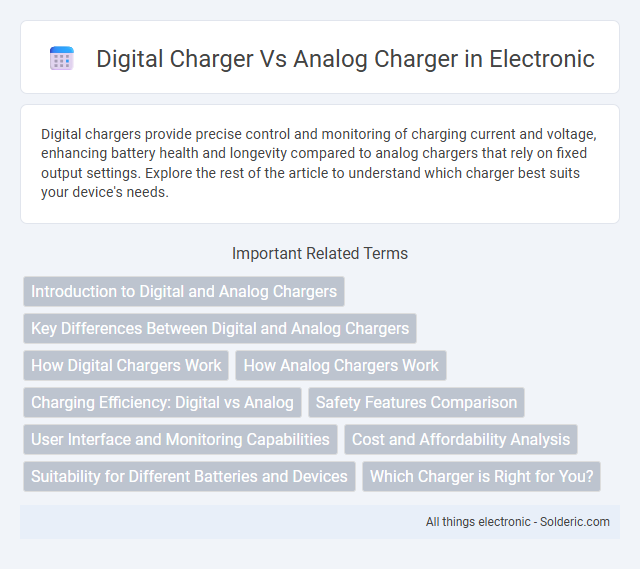Digital chargers provide precise control and monitoring of charging current and voltage, enhancing battery health and longevity compared to analog chargers that rely on fixed output settings. Explore the rest of the article to understand which charger best suits your device's needs.
Comparison Table
| Feature | Digital Charger | Analog Charger |
|---|---|---|
| Technology | Microprocessor-controlled charging | Mechanical or simple electronic circuits |
| Charging Accuracy | High; precise current and voltage regulation | Low; basic voltage and current delivery |
| Battery Protection | Advanced; overcharge, temperature, and short-circuit protection | Minimal to none; relies on manual operation |
| Charging Speed | Optimized; adaptive fast charging | Fixed; slower charging rate |
| Display/Feedback | Digital display, LED indicators, app connectivity | None or basic LED indicators |
| Energy Efficiency | High; reduced power wastage | Lower; more power lost as heat |
| Cost | Higher initial investment | Lower upfront cost |
| Use Case | Smart devices, professional and consumer electronics | Basic devices, low-cost applications |
Introduction to Digital and Analog Chargers
Digital chargers utilize microprocessors to precisely control charging voltage and current, enhancing battery life and efficiency. Analog chargers operate using fixed voltage regulators or simple circuitry, resulting in less adaptable and sometimes less efficient charging processes. Advances in battery technology have driven the adoption of digital chargers for optimized performance and safety in modern devices.
Key Differences Between Digital and Analog Chargers
Digital chargers provide precise control over charging current and voltage through microprocessor-based regulation, enabling optimized battery health and faster charging times. Analog chargers rely on simple circuitry with fixed voltage and current outputs, lacking adaptability to battery conditions, which can lead to overcharging and reduced battery lifespan. The key differences lie in their accuracy, efficiency, and the ability of digital chargers to dynamically adjust parameters based on real-time data compared to the constant output of analog models.
How Digital Chargers Work
Digital chargers use microprocessors to monitor and regulate the charging process with precision, ensuring optimal voltage and current delivery. They continuously adjust the power output based on the battery's condition and temperature, preventing overcharging and extending battery life. Your devices benefit from faster, safer charging cycles due to these intelligent control mechanisms.
How Analog Chargers Work
Analog chargers regulate voltage and current using simple components like resistors and transformers to deliver power to a device's battery. These chargers provide a continuous electrical flow without precise feedback mechanisms, resulting in less efficient energy transfer and potential overstressing of the battery. Their lack of smart control technology contrasts sharply with digital chargers, which use microcontrollers for optimized charging cycles and battery health monitoring.
Charging Efficiency: Digital vs Analog
Digital chargers utilize advanced circuitry and microprocessors to optimize power delivery, resulting in higher charging efficiency and reduced energy loss compared to analog chargers. Analog chargers rely on fixed voltage and current levels, often causing slower charge times and excess heat generation. Improving Your charging efficiency is more achievable with digital chargers, which adapt to device requirements for faster and safer power transfer.
Safety Features Comparison
Digital chargers incorporate advanced safety features such as precise voltage regulation, overcharge protection, and temperature monitoring, significantly reducing risks of overheating and battery damage. Analog chargers lack these automated controls, making them more prone to inconsistent charging and potential safety hazards. Choosing a digital charger enhances your device's safety by providing reliable, intelligent protection throughout the charging process.
User Interface and Monitoring Capabilities
Digital chargers offer advanced user interfaces with LCD or touchscreen displays that provide real-time data on charging status, battery health, and voltage levels, enabling precise control and customization. Analog chargers have simpler interfaces, usually featuring basic dial or LED indicators, which limit user interaction and detailed monitoring capabilities. Your choice of charger affects your ability to track charging performance and optimize battery maintenance through intuitive, data-driven insights.
Cost and Affordability Analysis
Digital chargers generally incur higher upfront costs due to advanced circuitry and features like precise current regulation and microprocessor control, which enhance battery life and efficiency. Analog chargers are more affordable initially but may result in higher long-term expenses due to less efficient charging and potential battery degradation. Cost analysis must consider total expenditure, including purchase price, energy efficiency, and maintenance to determine overall affordability.
Suitability for Different Batteries and Devices
Digital chargers offer precise charging algorithms that adapt to various battery chemistries such as Li-ion, NiMH, and LiFePO4, ensuring optimal charging efficiency and battery longevity. Analog chargers typically provide a fixed current or voltage output, making them less suitable for modern, sensitive batteries and smart devices that require tailored charging profiles. Devices with built-in battery management systems benefit from digital chargers because they minimize overcharging and enhance safety, whereas analog chargers are better suited for basic, sealed lead-acid or NiCd batteries with less complex requirements.
Which Charger is Right for You?
Digital chargers offer precise control over charging voltage and current, ensuring optimal battery health and faster charging times compared to analog chargers. Analog chargers, while simpler and often more affordable, lack advanced features like automatic shutoff or battery diagnostics, making them better suited for basic charging needs. Your choice depends on whether you prioritize efficiency and battery longevity with a digital charger or prefer the simplicity and lower cost of an analog charger.
digital charger vs analog charger Infographic

 solderic.com
solderic.com